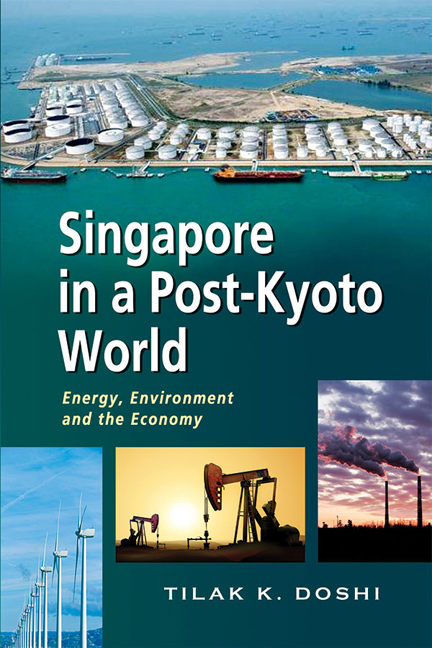Book contents
- Frontmatter
- Dedication
- Contents
- List of Tables and Figures
- Preface
- Acknowledgements
- List of Abbreviations
- Introduction
- 1 Economy, Energy, and Emissions
- 2 Climate Change Negotiations: From Copenhagen to Durban via Cancun
- 3 Climate Change Finance: Who Pays and Who Receives?
- 4 Singapore's External Sector: Impacts of Emission Mitigation Policies
- 5 Energy and Emissions: The Five Strategies
- 6 Concluding Remarks: “The Three E's”
- Index
- About the Author
1 - Economy, Energy, and Emissions
Published online by Cambridge University Press: 19 May 2017
- Frontmatter
- Dedication
- Contents
- List of Tables and Figures
- Preface
- Acknowledgements
- List of Abbreviations
- Introduction
- 1 Economy, Energy, and Emissions
- 2 Climate Change Negotiations: From Copenhagen to Durban via Cancun
- 3 Climate Change Finance: Who Pays and Who Receives?
- 4 Singapore's External Sector: Impacts of Emission Mitigation Policies
- 5 Energy and Emissions: The Five Strategies
- 6 Concluding Remarks: “The Three E's”
- Index
- About the Author
Summary
Singapore is among the most affluent and urbanized countries in the world. It rapidly grew from a colonial island-entrepôt with a gross domestic product (GDP) per capita of US$428 in 1960 to a vibrant global city-state with a GDP per capita of US$55,183 in 2013 at market prices. Reclamation of land has resulted in the expansion of Singapore's land area to approximately 710.3 km2 in 2009 from 581.5 km² in the 1960s. With an estimated population of 5.08 million in 2009, Singapore's population density stands at 7,100/km2. This makes it one of the most densely populated countries in the world.
In international rankings of per capita carbon dioxide (CO2) emissions (as in Table 1.1 below), Singapore is comparable to such developed Asian industrial economies as South Korea and Japan, significantly lower than resource-rich Organisation for Economic Co-operation and Development (OECD) economies such as Australia and the United States, and much lower than the rich, small petroleum-based states such as Qatar and the United Arab Emirates (UAE). As an affluent city-state, Singapore's per capita emissions are significantly higher than the more populous, middle-income developing countries such as its neighbours Malaysia and Thailand, and much higher than China and India with their huge populations and lower per capita incomes.
The key attribute of Singapore's uniqueness in terms of energy and emissions is that it is a city-state, in a world of generally larger, lessurbanized countries. This fact of high population density and urbanization skews per capita indicators of wealth, energy use, and CO2 emissions. In any consistent ranking, Singapore would need to be appropriately compared to other global cities and their immediate suburban environs such as Hong Kong, Dubai, London, Houston, or Sydney. And even when such comparisons are made, allowances are required for the fact that for most of these cities, actual emissions caused by households and businesses in the cities are associated with electricity which is usually generated outside city limits.
- Type
- Chapter
- Information
- Singapore in a Post-Kyoto WorldEnergy, Environment and the Economy, pp. 5 - 17Publisher: ISEAS–Yusof Ishak InstitutePrint publication year: 2015

